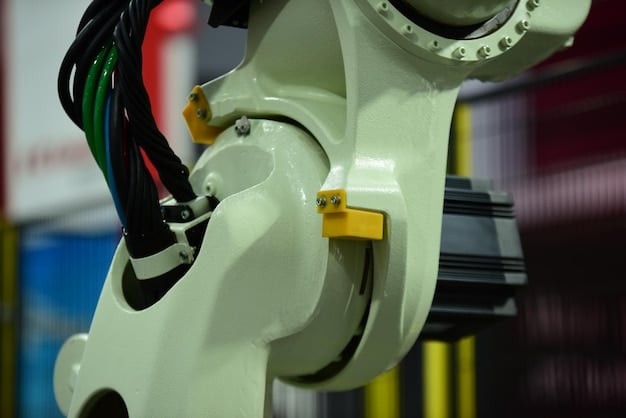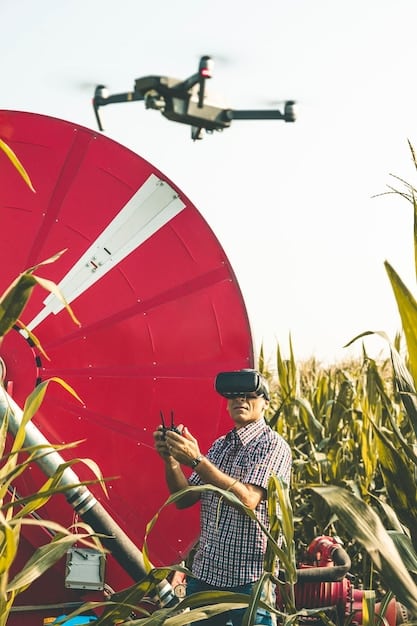Robotics and Automation: Transforming US Industries by 2025

Robotics and automation are revolutionizing US industries in 2025, enhancing efficiency, productivity, and innovation across sectors like manufacturing, healthcare, logistics, and agriculture, with anticipated widespread adoption driven by technological advancements and economic benefits.
The landscape of American industries is undergoing a dramatic shift, and at the forefront of this transformation are robotics and automation: How They’re Transforming US Industries in 2025. As we approach the mid-decade mark, the integration of robots and automated systems is no longer a futuristic concept but a present-day reality, reshaping how businesses operate and compete.
The Rise of Robotics in American Manufacturing
Manufacturing has always been a cornerstone of the US economy, and robotics is playing an increasingly vital role in its evolution. Robotics and automation: How They’re Transforming US Industries in 2025 are not just about replacing human workers; it’s about augmenting their capabilities and creating a more efficient and competitive manufacturing sector.
The adoption of robots in manufacturing has led to significant improvements in production speed, precision, and quality. By automating repetitive and physically demanding tasks, manufacturers can reduce errors, minimize waste, and increase output. This allows them to meet growing demand, improve profitability, and maintain a competitive edge in the global market.
Key Benefits of Robotics in Manufacturing
The integration of robotics into manufacturing processes brings several key benefits:
- Increased Efficiency: Robots can operate 24/7 without breaks, leading to higher production volumes and faster turnaround times.
- Improved Precision: Automated systems can perform tasks with greater accuracy and consistency than human workers, reducing defects and improving product quality.
- Enhanced Safety: Robots can handle hazardous materials and perform dangerous tasks, protecting human workers from injury.
- Reduced Costs: While the initial investment in robotics can be significant, the long-term cost savings from increased efficiency and reduced waste can be substantial.
In conclusion, the rise of robotics in American manufacturing is undeniable. As companies continue to seek ways to optimize their operations and stay competitive, the adoption of robotic solutions will only accelerate in the coming years, solidifying robotics and automation: How They’re Transforming US Industries in 2025.

Automation in Healthcare: Improving Patient Care and Efficiency
The healthcare industry is facing numerous challenges, including rising costs, increasing patient volume, and a shortage of skilled workers. Automation offers a promising solution to these challenges, with robotic systems and automated processes poised to transform various aspects of healthcare delivery. Robotics and automation: How They’re Transforming US Industries in 2025 can enhance efficiency, improve patient care, and reduce the burden on healthcare professionals.
Robotic surgery, for example, allows surgeons to perform complex procedures with greater precision, minimizing invasiveness and reducing recovery times for patients. Automated dispensing systems can improve medication accuracy and reduce the risk of errors, while robotic nurses can assist with patient monitoring and basic care tasks.
Applications of Automation in Healthcare
Automation is transforming healthcare through:
- Robotic Surgery: Enhancing surgical precision, reducing invasiveness, and improving patient outcomes.
- Automated Dispensing Systems: Ensuring accurate medication delivery and reducing errors in pharmacies.
- Robotic Nursing Assistants: Assisting with patient monitoring, vital sign measurement, and basic care tasks.
- Automated Laboratory Testing: Accelerating sample analysis and improving the accuracy of diagnostic tests.
The integration of automation in healthcare is not about replacing human caregivers but about empowering them to focus on tasks that require their unique skills and expertise, such as critical thinking, complex decision-making, and emotional support. By automating routine and repetitive tasks, healthcare professionals can dedicate more time to personalized patient care, leading to improved health outcomes. In 2025, robotics and automation: How They’re Transforming US Industries in 2025 are vital for optimized healthcare practices.
Logistics and Warehousing: Streamlining Operations with Automation
The logistics and warehousing industries are critical links in the supply chain, responsible for the efficient movement of goods from manufacturers to consumers. With the rise of e-commerce and increasing demand for faster delivery times, these industries are facing unprecedented pressure to optimize their operations. Robotics and automation: How They’re Transforming US Industries in 2025 are playing a crucial role in streamlining logistics and warehousing processes, enabling companies to meet growing customer expectations.
Automated guided vehicles (AGVs) and autonomous mobile robots (AMRs) are being used to transport goods within warehouses, optimizing storage and retrieval operations. Robotic picking and packing systems can automate order fulfillment, reducing errors and increasing throughput. These technologies are enabling companies to process orders faster, reduce labor costs, and improve overall efficiency.
How Automation Enhances Logistics
Here’s how automation can optimize logistics and warehousing:
- Automated Guided Vehicles (AGVs): Transporting goods within warehouses, improving efficiency and reducing labor costs.
- Autonomous Mobile Robots (AMRs): Offering flexible and scalable solutions for warehouse automation, adapting to changing needs.
- Robotic Picking and Packing Systems: Automating order fulfillment, reducing errors, and increasing throughput.
- Automated Inventory Management: Using sensors and data analytics to track inventory levels and optimize storage strategies.
In conclusion, automation is revolutionizing the logistics and warehousing industries, enabling companies to meet the growing demands of e-commerce and improve customer satisfaction. As technology continues to advance and costs decrease, the adoption of robotic solutions will only accelerate, further transforming these critical sectors. Robotics and automation: How They’re Transforming US Industries in 2025 are, therefore, fundamental advancements for this economy.
Agriculture: Robots Cultivating the Future of Farming
The agriculture industry is facing the daunting challenge of feeding a growing global population with limited resources. Automation offers a promising solution to this challenge, with robotic systems and automated processes poised to transform various aspects of farming. Robotics and automation: How They’re Transforming US Industries in 2025 can improve efficiency, reduce labor costs, and minimize environmental impact.
Robotic tractors and harvesters can automate planting, harvesting, and other field operations, reducing the need for manual labor. Drones equipped with sensors and cameras can monitor crop health, identify pests and diseases, and optimize irrigation and fertilization. These technologies are enabling farmers to increase yields, reduce waste, and improve the sustainability of their operations.

Robotic Applications in Agriculture
Robots are being applied to many dimensions of agriculture, including:
- Robotic Tractors and Harvesters: Automating planting, harvesting, and other field operations, reducing labor costs.
- Drones for Crop Monitoring: Monitoring crop health, identifying pests and diseases, and optimizing irrigation and fertilization.
- Automated Weeding Systems: Precisely removing weeds without the use of harmful herbicides.
- Robotic Milking Systems: Automating the milking process, increasing efficiency and improving animal welfare.
In conclusion, automation is playing an increasingly important role in agriculture, enabling farmers to produce more food with fewer resources. As technology continues to advance and costs decrease, the adoption of robotic solutions will only accelerate, paving the way for a more sustainable and efficient agricultural sector. Robotics and automation: How They’re Transforming US Industries in 2025 ensure future stability and growth for the agricultural sector.
Addressing the Challenges of Automation
While automation offers numerous benefits, it also presents certain challenges that must be addressed to ensure a smooth and equitable transition. One of the main concerns is the potential displacement of human workers as robots and automated systems take over their jobs. Proactive measures must be taken to mitigate this risk, such as investing in retraining and education programs to help workers acquire new skills and transition to new roles.
Another challenge is the need for standardization and interoperability. As more and more companies adopt robotic solutions, it’s essential to ensure that these systems can communicate and work together seamlessly. This requires the development of common standards and protocols, as well as collaboration between manufacturers, researchers, and policymakers.
Mitigating the Challenges of Automation
To mitigate these challenges, various solutions can be implemented:
- Investing in Retraining and Education: Providing workers with the skills they need to thrive in the automated economy.
- Developing Common Standards: Ensuring interoperability and compatibility between different systems.
- Promoting Collaboration: Encouraging cooperation between manufacturers, researchers, and policymakers.
- Creating New Job Opportunities: Fostering innovation and entrepreneurship to generate new employment opportunities.
Robotics and automation: How They’re Transforming US Industries in 2025 does come with its challenges but, by proactively addressing these challenges and implementing appropriate solutions, we can ensure that the benefits of automation are shared broadly and that the transition is smooth and equitable for all.
The Future of Robotics and Automation in the US
Looking ahead, the future of robotics and automation: How They’re Transforming US Industries in 2025 in the US is bright, with continued advancements in technology and decreasing costs driving widespread adoption across various industries. Artificial intelligence (AI) will play an increasingly important role, enabling robots to perform more complex and autonomous tasks.
Collaborative robots (cobots), designed to work alongside human workers, will become more prevalent, blurring the lines between human and machine labor. The Internet of Things (IoT) will enable seamless integration of robots and automated systems into broader networks, creating smart factories, smart warehouses, and smart farms.
Future Trends in Robotics and Automation
Robotics and automation will continue to evolve thanks to:
- Artificial Intelligence (AI): Enabling robots to perform more complex and autonomous tasks.
- Collaborative Robots (Cobots): Working alongside human workers, enhancing productivity and safety.
- Internet of Things (IoT): Connecting robots and automated systems to broader networks, creating smart environments.
- Advanced Sensors and Vision Systems: Providing robots with greater awareness of their surroundings, enabling them to adapt to changing conditions.
In conclusion, we can expect to see exciting developments in the years to come, the continued evolution and integration of automation and robotics will redefine how businesses operate, how products are made, and how services are delivered, driving economic growth and improving our quality of life. Industries across the spectrum, from manufacturing to healthcare, will continue to be reshaped and optimized by the possibilities of a 2025 landscape of robotics and automation: How They’re Transforming US Industries in 2025.
| Key Aspect | Brief Description |
|---|---|
| 🏭 Manufacturing | Robots increase efficiency and precision in production processes. |
| 🩺 Healthcare | Automation enhances surgery, medication management, and patient care. |
| 📦 Logistics | AGVs and AMRs streamline warehousing and delivery operations. |
| 🌱 Agriculture | Robots and drones optimize crop management and reduce labor. |
FAQ
Robotics in manufacturing leads to increased efficiency, higher precision, improved safety, and reduced operational costs. They can operate continuously and handle dangerous tasks.
Automation enhances patient care through robotic surgery, automated dispensing systems, and robotic nursing assistants. These technologies improve accuracy and allow caregivers to focus on personalized attention.
Robots like AGVs and AMRs are streamlining logistics and warehousing. They automate the transport of goods, optimize storage, and accelerate order fulfillment processes.
In agriculture, robots and drones are used for planting, harvesting, crop monitoring, and weeding. These technologies help increase yields, reduce waste, and improve the sustainability of farming.
Challenges include the potential displacement of human workers, the need for retraining programs, and ensuring standardization and interoperability of robotic systems across different sectors.
Conclusion
As we advance into 2025, it’s clear that robotics and automation are not just trends, but fundamental shifts transforming US industries. Embracing these technologies and addressing their associated challenges will be crucial for staying competitive and fostering sustainable economic growth in the years to come.





